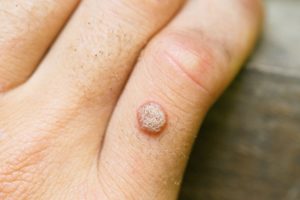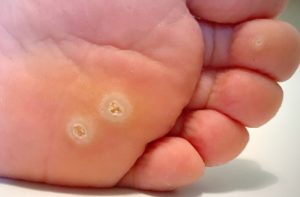Warts

Like molluscum contagiosum, warts develop because of a viral infection called human papillomavirus (HPV), within the top layer of the skin (also known as the epidermis).
Warts and the viruses that cause them are highly contagious. Most appear skin colored, and feel rough and scaly to the touch, however they can also be darker in color and smooth.
There are a few different types including common (verruca vulgaris); foot (plantar); flat and filiform.
Common warts (verruca vulgaris): These are the most common type. They tend to appear on the hands, fingers, and near the nails. They are more likely to appear where skin is broken. Children often get these, and they are highly contagious through touch. If you notice a wart on your child, make sure to check other parts of their body– for example, a wart may appear on the face if your child has one on their finger and has touched their face.

Foot warts (plantar warts): As you would guess, this type develops only on the soles (bottoms) of the feet and can be very painful. The pain is often described as the feeling of stepping on a small rock or pebble, and they tend to grow inward which can create pressure when walking or participating in activities. This type can be tricky to treat.
Flat warts: These can occur anywhere on the body. In men, they tend to grow most commonly on the face around the beard area, and in women, we see them most often on the legs. These are typically smaller and more smooth. The often grow in large numbers ranging anywhere from 20 to 100 at one time.
Filiform warts: This type is less common than others. They look like long, threads, or even small thin fingers that protrude from the skin. These tend to grow quickly and often appear on the face.

